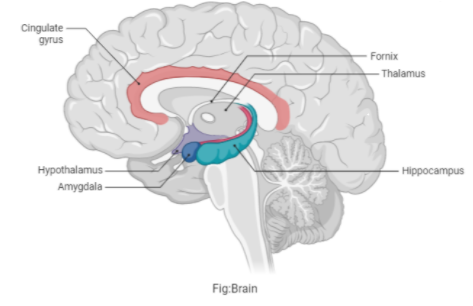
Floor of the third ventricle is known as
A. Optic thalami
B. Pallium
C. Hypothalamus
D. Epithalamus
Answer
465.9k+ views
Hint: A total of four ventricles comprises the brain. In each hemisphere, the first and the second are present. The third ventricle is located separately, even though it has some similar functions to the other ventricles.
Complete answer: The hypothalamus is a part of the forebrain. The thalamus is positioned at the root. On the anterior surface, a cross-like structure is discovered by a hypothalamus called optic chiasma. It transfers visual signals resurrected from the eyes to the cerebral hemisphere. If this portion is lost by chance, animals become blind. An infundibulum binds the pituitary body to the middle part of the hypothalamus. The hypothalamus regulates appetite, thirst, exhaustion, sleep, body temperature sweating and emotions centres. The third ventricle floor is known as the hypothalamus.
i. Optical thalami: This section of the brain, known as the optic thalamus, was later identified as a large mass of grey matter involving visual stimuli and all sensory modalities, with the exception of smell, were processed.
ii. Pallium: It refers to the layers of grey and white matter covering the vertebrate upper surface of the cerebrum.
iii. Epithalamus: Diencephalon encloses the third ventricle, a slit-like cavity. The thin roof of this cavity is referred to as the epithalamus, the thick sides of the right and left as the thalamus and the epithalamus as the surface. Nervous tissue does not form an epithalamus. It consists only of pia mater.
Hence, the correct answer is option C.

Note: In each of the brain's ventricles, the teal choroidea is present and adheres to the ependyma and is where the choroid plexus is developed. There is a rare third ventricle tumour known as chordoid glioma. All ventricles arise from the neural tube canal. Ventricles filled with cerebrospinal fluid (CSF) are classified as cavities of the brain. CSF formation occurs by plasma secretion.
Complete answer: The hypothalamus is a part of the forebrain. The thalamus is positioned at the root. On the anterior surface, a cross-like structure is discovered by a hypothalamus called optic chiasma. It transfers visual signals resurrected from the eyes to the cerebral hemisphere. If this portion is lost by chance, animals become blind. An infundibulum binds the pituitary body to the middle part of the hypothalamus. The hypothalamus regulates appetite, thirst, exhaustion, sleep, body temperature sweating and emotions centres. The third ventricle floor is known as the hypothalamus.
i. Optical thalami: This section of the brain, known as the optic thalamus, was later identified as a large mass of grey matter involving visual stimuli and all sensory modalities, with the exception of smell, were processed.
ii. Pallium: It refers to the layers of grey and white matter covering the vertebrate upper surface of the cerebrum.
iii. Epithalamus: Diencephalon encloses the third ventricle, a slit-like cavity. The thin roof of this cavity is referred to as the epithalamus, the thick sides of the right and left as the thalamus and the epithalamus as the surface. Nervous tissue does not form an epithalamus. It consists only of pia mater.
Hence, the correct answer is option C.

Note: In each of the brain's ventricles, the teal choroidea is present and adheres to the ependyma and is where the choroid plexus is developed. There is a rare third ventricle tumour known as chordoid glioma. All ventricles arise from the neural tube canal. Ventricles filled with cerebrospinal fluid (CSF) are classified as cavities of the brain. CSF formation occurs by plasma secretion.
Recently Updated Pages
Master Class 11 Economics: Engaging Questions & Answers for Success

Master Class 11 Business Studies: Engaging Questions & Answers for Success

Master Class 11 Accountancy: Engaging Questions & Answers for Success

The correct geometry and hybridization for XeF4 are class 11 chemistry CBSE

Water softening by Clarks process uses ACalcium bicarbonate class 11 chemistry CBSE

With reference to graphite and diamond which of the class 11 chemistry CBSE

Trending doubts
What are the elders in Goa nostalgic about class 11 social science CBSE

Formaldehyde at room temperature is ALiquid BGas CSolid class 11 chemistry CBSE

Define least count of vernier callipers How do you class 11 physics CBSE

Distinguish between Mitosis and Meiosis class 11 biology CBSE

Why are forests affected by wars class 11 social science CBSE

Explain zero factorial class 11 maths CBSE




